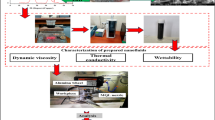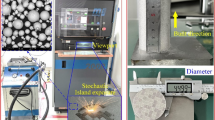Abstract
Impact and abrasion properties of various commercial US grinding balls were evaluated and compared by the Bureau of Mines, US Department of the Interior. Laboratory tests were conducted on balls obtained from eight major US manufacturers. The balls included forged steel, cast steel, and alloyed white cast iron and were subjected to repeated impacts until they broke or until 300,000 impacts were exceeded. Pin abrasion tests also were conducted. The results showed wide differences in impact lives, ranging from a few thousand to over 500,000 impacts. The life of inferior commercial balls was increased five to six times by a laboratory tempering heat treatment. For balls that did not break, the major impact wear mode was spalling and ranged from an average rate of 0.28 to 4.46 mg per impact. The softest balls (steel) had excellent impact resistance but low abrasion resistance. The abrasion resistance of the steel balls generally increased with hardness. The alloyed white cast irons had about twice the abrasion resistance of the steel balls. Users should become aware of the wide variations among commercial balls, and ball manufacturers should be aware that their product can be improved.
Similar content being viewed by others
References
Avery, H. S., 1961, “The Measurement of Wear Resistance,” Wear, Vol. 4 , pp. 427–449.
Blickensderfer, R. and Laird, G., 1987, “A Pin-on-Drum Abrasive Wear Test and Comparison With Other Pin Wear Tests, Tribological Mechanisms and Wear Problems in Materials,” ASM International, October, pp. 71–83.
Blickensderfer, R. and Tylczak, J. H., 1983, “A Large Scale Impact Spalling Test,” Wear, Vol. 84, pp. 363–373.
Blickensderfer, R., Tylczak, J. H., and Dodd, J., 1983, “The Effect of Heat Treatment on Spalling of a Cr-Mo White Cast Iron,” Wear of Materials 1983, ASME, pp. 471–47 6.
Diesburg D. F. and Borik, F., 1975, “Optimizing Abrasion Resistance,” Proceedings, Symposium, Materials for the Mining Industry, Climax Molybdenum Co., Greenwich, CT, pp. 15–41.
Dixon, R. H. T., 1961, “Some Effects of Heat Treatment Upon the Impact Fatigue Life of Ni-Hard Grinding Balls,” Journal, Iron and Steel Institute, Vol. 197, pp. 40–48.
Durman R. W., 1973, “Basic Metallurgical Concepts and the Mechanical Testing of Some Abrasion-resistant Alloys,” Foundry Trade Journal, May 24, pp. 645–651.
El-Koussy R., El-Raghy, S. M., and El-Mehairy, A. E., 1981, “Effect of Heat Treatment Conditions and Composition on the Wear Resistance of Some Chromium Steels,” Tribology International, pp. 323–28.
Farge, J. C. and Barclay, E. A., 1975, “Properties and Performance of Cast-Iron Grinding Ball,” Proceedings, Symposium, Materials for the Mining Industry, Climax Molybdenum Co., Greenwich, CT, pp. 189–199.
Gundlach, R. B. and Parks, J. L., 1978, “Influence of Abrasive Hardness on the Wear Resistance of High Chromium Irons,” Wear, Vol. 46, pp. 97–108.
Howat D. D., 1983, “An Assessment of the Merits of Various Types of Balls in the Milling of Ores,” Mintek Report M117, Council for Mineral Tech., Randburg, South Africa, Nov., p. 20.
Krushchov, M. M. and Babichev, M. A., 1956, “Investigation of the Wear of Metals and Alloys by Rubbing on an Abrasive Surface,” Friction and Wear in Machinery, Vol. 11, 12 pp.
Malghan, S. G., 1982, “Methods to Reduce Steel Wear in Grinding Mills,” Mining Engineering, June pp. 684–90.
Moore, J. J., et al., 1984, “The Effect of Grinding Ball Composition and Mineral Slurry Environment on Grinding Media Wear,” paper C352/84, Tribology in Mineral Extraction War on Wear, Institution of Mechanical Engineers Conference Publications, London, pp. 215–226.
Moroz, P. J. and Lorenzetti, J. J., 1981, “The Effects of Matrix Hardness and Microstructure on the Wear of Steel Grinding Ball During Wet Copper Ore Grinding,” Wear of Materials 1981, ASME, pp. 280–289.
Muscara, J. and Sinnott, M. J., 1972, “Construction and Evaluation of a Versatile Abrasive Wear Testing Apparatus,” Met. Eng. Q., Vol. 12, No. 2, pp. 21–32.
Mutton, P. J., 1978, “High Stress Abrasion Testing of Wear Resistant Materials,” Lab. Rep. MRL/PM3/78/001. Broken Hill Proprietary Co., Melbourne Res. Lab. (Australia), Aug., 49 pp.
Nass, D. E., 1974, “Steel Grinding Media Used in the United States and Canada,” Proceedings, Symposium, Materials for the Mining Industry, Climax Molybdenum Co., Greenwich, CT, 1975, pp. 173–188.
Norman, T. E., 1948, “Wear Test of Grinding Balls,” Trans. AIME, Vol. 176, pp. 490–526.
Tylczak, J. H., Singleton, D. J., and Blickensderfer, R., 1986, “Wear of 12 Alloys During Milling of Phosphate Rock in Phosphoric Acid Waste Water,” Minerals and Metallurgical Processing, Aug, pp. 187–190.
Author information
Authors and Affiliations
Additional information
M&MP paper 88–653. Discussion of this paper must be submitted, in duplicate, prior to Jul. 31, 1989.
Rights and permissions
About this article
Cite this article
Blickensderfer, R., Tylczak, J.H. Evaluation of commercial US grinding balls by laboratory impact and abrasion tests. Mining, Metallurgy & Exploration 6, 60–66 (1989). https://doi.org/10.1007/BF03402527
Received:
Published:
Issue Date:
DOI: https://doi.org/10.1007/BF03402527




